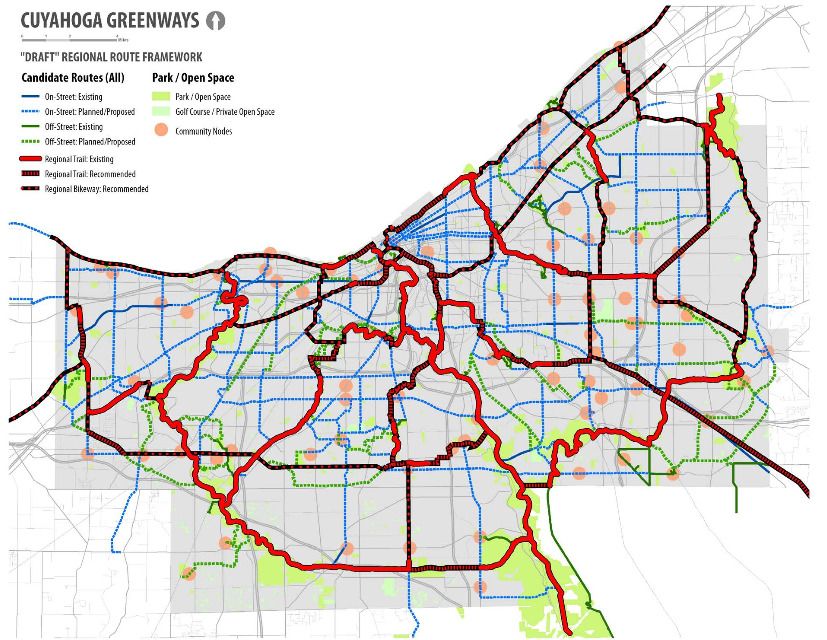Last year, Cleveland Metroparks celebrated its centennial. For the past 100 years, the agency has been implementing founder William Stinchcomb’s vision for an “emerald necklace” of green space ringing Cleveland. Today, Metroparks manages 23,000 acres of parks and green space. Now, the agency, along with the Cuyahoga County Planning Commission and metropolitan planning organization NOACA, wants to expand on the emerald necklace with a new network of greenways and bike infrastructure connecting Cleveland’s parks with each other and with the 58 other cities and towns in Cuyahoga County.
If fully implemented, the Cuyahoga Greenway will eventually include hundreds of miles of linear parks with biking and walking trails as well as on-road bike lanes to provide more connectivity.
“We’re building off the excitement of the centennial of Metroparks, to think about what the next century will look like,” says Glenn Coyne, Cuyahoga County Planning Commission executive director. “We’re really thinking about how we connect the rest of the county with a system of greenways and regional trails that not only link into the emerald necklace and provide access to lakes and parks, but also connect inner and outer ring suburbs.”
The Greenway is still in the early planning stages. The planning commission is working with a consultant and hosting community meetings to establish the ideal routes for the greenway. Once they figure out the where, they’ll determine whether a dedicated trail or a bike lane is best for a given location.
Coyne says the fundamental goal of the trail and bike lane network is to encourage more people to bike. “The local communities are very interested in alternative forms of transportation. We don’t want to get in our car and drive everywhere. This is an effort to think about how can we use walking, biking and transit to get around and link up our communities.”
He continues, “We’ve emphasized all along that this is not just for the spandex commuter folks. It’s for everyone. Safety is a big concern.”
Unsurprisingly, bike advocates are encouraged by the possibilities of a bike network that connects the dots.
“It’s really exciting to have agencies thinking about connectivity on a much larger scale across the county,” says Jacob VanSickle, Bike Cleveland executive director. “Cleveland has done a good job over the last four to five years building out bikeways and trails, but in a lot of instances they don’t connect people anywhere. As you build out a connected network, you start to see more people out riding that you wouldn’t have previously seen because it’s a safe place to do it.”
Bike Cleveland focuses primarily on advocacy within Cleveland city limits. They are working with the city to update the Bikeway Master Plan, which they are pushing to include more protected bike lanes and center-running bike lanes that repurpose former streetcar lanes. The city population is currently less than half its 1950’s peak, leaving lots of space on its wide, auto-centric boulevards for protected bike infrastructure.
Bike Cleveland is also working with Rails to Trails Conservancy to do a connectivity analysis to determine gaps in their network and ideal locations for low-stress bike infrastructure. VanSickle says both the master plan and connectivity analysis should intersect well with the Greenway plan to improve biking conditions in the city and county.
Funding is always a challenge for implementing something like the Cuyahoga Greenway. Coyne says the number of governments involved in the Greenway’s implementation adds a unique difficulty. “Almost the entire county is incorporated as 59 cities,” he explains. “They all have their own home rule and authority for regulations and planning in community.”
Coyne says the planning commission is working now to gather input from all the communities in an effort to get buy in early. One of goals with the Greenway Plan is to have it act as a master list of projects that get integrated with local municipalities public works projects. Coyne says, “We’ll be able to build the greenway incrementally. As municipalities repave a road and build new developments, we can get these trails and bike lanes in.”
The Cuyahoga Greenway is still a long way from reality. Coyne points out it took decades for Metroparks to complete the 1917 emerald necklace vision. The planning commission is shooting for completing its final greenway plan this July.
This article is part of The Power of Parks, a series exploring how parks and recreation facilities and services can help cities achieve their goals in wellness, conservation and social equity. The Power of Parks is supported by a grant from the National Recreation and Park Association.

Josh Cohen is Crosscut’s city reporter covering Seattle government, politics and the issues that shape life in the city.
Follow Josh .(JavaScript must be enabled to view this email address)
















